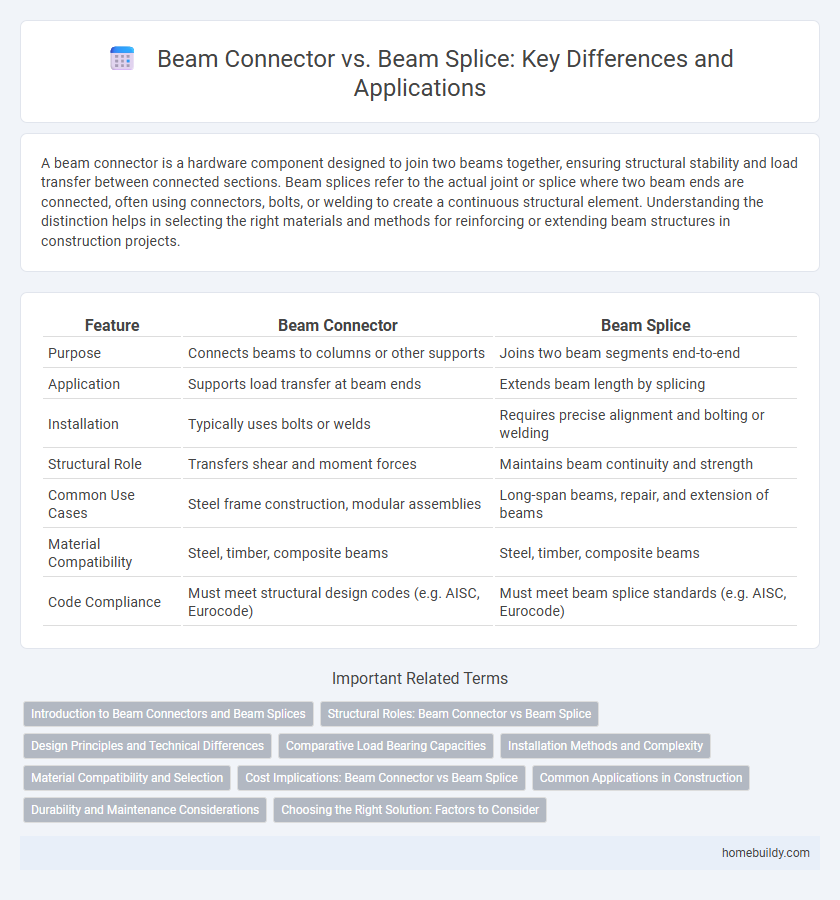A beam connector is a hardware component designed to join two beams together, ensuring structural stability and load transfer between connected sections. Beam splices refer to the actual joint or splice where two beam ends are connected, often using connectors, bolts, or welding to create a continuous structural element. Understanding the distinction helps in selecting the right materials and methods for reinforcing or extending beam structures in construction projects.
Table of Comparison
| Feature | Beam Connector | Beam Splice |
|---|---|---|
| Purpose | Connects beams to columns or other supports | Joins two beam segments end-to-end |
| Application | Supports load transfer at beam ends | Extends beam length by splicing |
| Installation | Typically uses bolts or welds | Requires precise alignment and bolting or welding |
| Structural Role | Transfers shear and moment forces | Maintains beam continuity and strength |
| Common Use Cases | Steel frame construction, modular assemblies | Long-span beams, repair, and extension of beams |
| Material Compatibility | Steel, timber, composite beams | Steel, timber, composite beams |
| Code Compliance | Must meet structural design codes (e.g. AISC, Eurocode) | Must meet beam splice standards (e.g. AISC, Eurocode) |
Introduction to Beam Connectors and Beam Splices
Beam connectors and beam splices serve essential roles in structural engineering by joining beams together to ensure stability and load transfer. Beam connectors typically provide a mechanical connection between steel or wood beams, facilitating ease of assembly and flexibility in design. In contrast, beam splices are often used to extend the length of beams, creating a continuous member by joining two beam sections end-to-end, usually through welding, bolting, or specialized connectors.
Structural Roles: Beam Connector vs Beam Splice
Beam connectors serve as critical components that transfer shear forces between adjoining beams, ensuring load distribution within a structure. Beam splices specifically join two beam segments end-to-end to restore continuity and strength along the beam's length. While beam connectors emphasize lateral load transfer and stability, beam splices focus on re-establishing axial and bending capacity in segmented beams.
Design Principles and Technical Differences
Beam connectors and beam splices serve distinct structural roles with differing design principles and technical characteristics. Beam connectors are designed to transfer shear and bending forces between beams and supporting elements, emphasizing ease of installation and load distribution without altering beam continuity. In contrast, beam splices restore beam continuity by joining two beam segments, requiring precise alignment and weld or bolt design to ensure moment transfer and structural integrity.
Comparative Load Bearing Capacities
Beam connectors typically offer higher load-bearing capacities due to their integrated design that distributes stress evenly across the joint. Beam splices may have lower capacity because they rely on overlapping sections fastened together, potentially creating stress concentration points. Structural engineers often prefer beam connectors in critical load scenarios to ensure enhanced stability and safety.
Installation Methods and Complexity
Beam connectors typically feature simpler installation methods, often involving fewer components and faster assembly using bolts or welds, making them ideal for straightforward connections. Beam splices generally require more precise alignment and additional preparation, such as drilling or machining, resulting in increased complexity and longer installation times. The choice between beam connectors and beam splices depends on project requirements for speed, structural integrity, and ease of installation.
Material Compatibility and Selection
Beam connectors must be chosen based on material compatibility to ensure structural integrity and corrosion resistance, particularly when joining steel to aluminum or other metals. Beam splices typically require precise alignment and may involve welding or bolting methods tailored to the specific materials, making the selection process critical to prevent galvanic corrosion and maintain load-bearing capacity. Proper evaluation of material properties such as thermal expansion and tensile strength is essential in both connectors and splices to optimize long-term performance.
Cost Implications: Beam Connector vs Beam Splice
Beam connectors typically offer lower installation costs compared to beam splices due to simplified fastening methods and reduced labor time. While beam splices require precise alignment and often involve welding or bolting that can increase material and labor expenses, beam connectors streamline assembly with prefabricated components. This cost efficiency makes beam connectors a preferred choice in projects aiming to optimize budget without compromising structural integrity.
Common Applications in Construction
Beam connectors are commonly used in construction to join beams at various angles, providing structural support in frameworks such as roof trusses and floor systems. Beam splices primarily serve to extend the length of beams by connecting two sections end-to-end, often used in long-span bridges and large commercial buildings. Both components enhance load distribution and structural integrity but cater to different design requirements and load scenarios.
Durability and Maintenance Considerations
Beam connectors offer superior durability due to their robust design, often featuring corrosion-resistant materials that enhance long-term performance in structural applications. Maintenance for beam connectors is typically minimal, as their secure fastening reduces the likelihood of loosening or wear compared to beam splices, which may require periodic inspection and tightening. The consistent load distribution provided by beam connectors also mitigates stress concentrations, contributing to lower maintenance demands and extended service life.
Choosing the Right Solution: Factors to Consider
Beam connectors provide flexible and efficient connections suitable for various structural designs, while beam splices ensure continuity in long beams by joining sections end-to-end. When choosing between a beam connector and a beam splice, factors such as load requirements, installation complexity, and material compatibility must be carefully evaluated. Structural engineers should also consider ease of inspection, maintenance needs, and the specific application's dynamic forces to determine the optimal connection method.
Beam connector vs Beam splice Infographic

 homebuildy.com
homebuildy.com